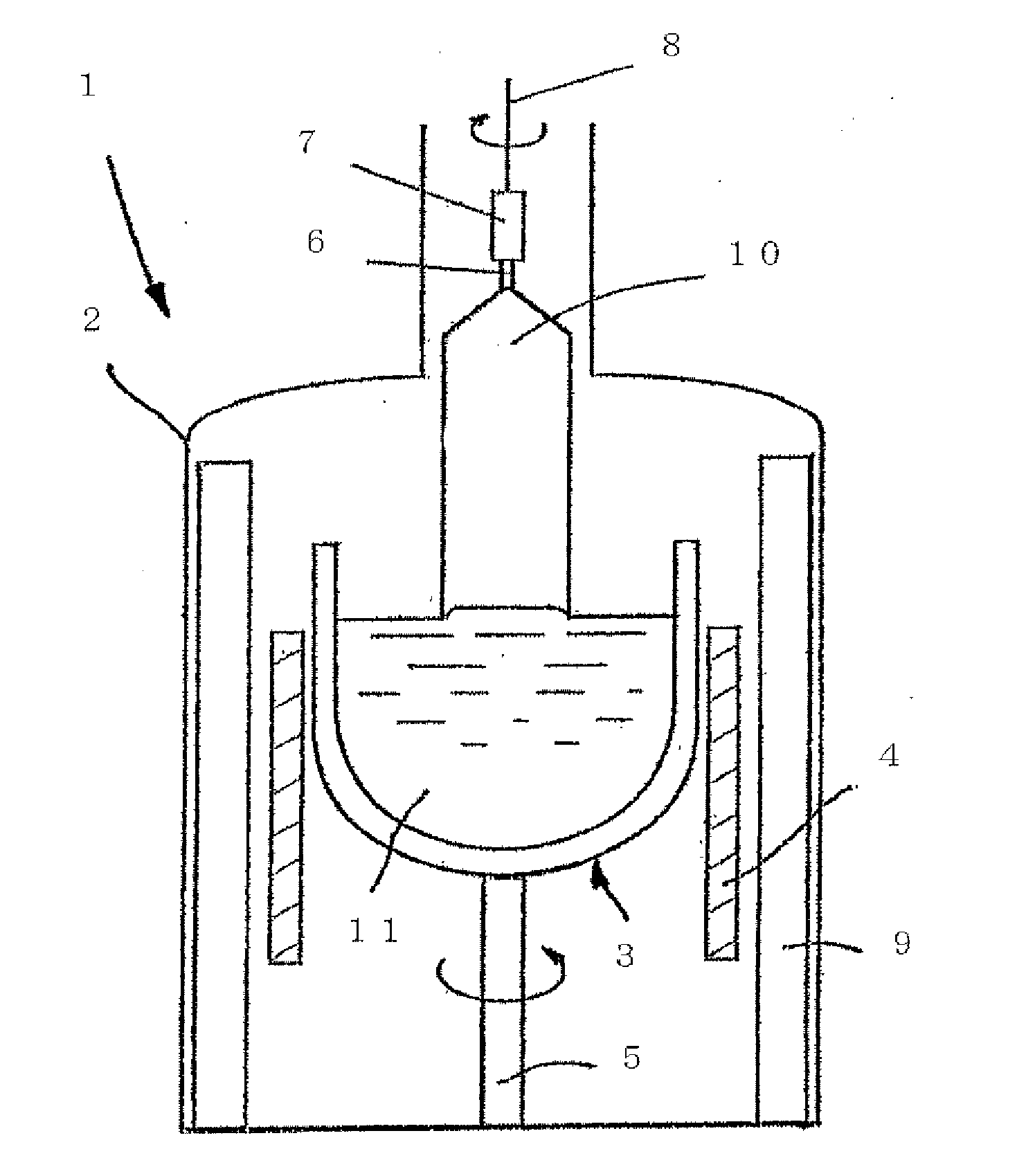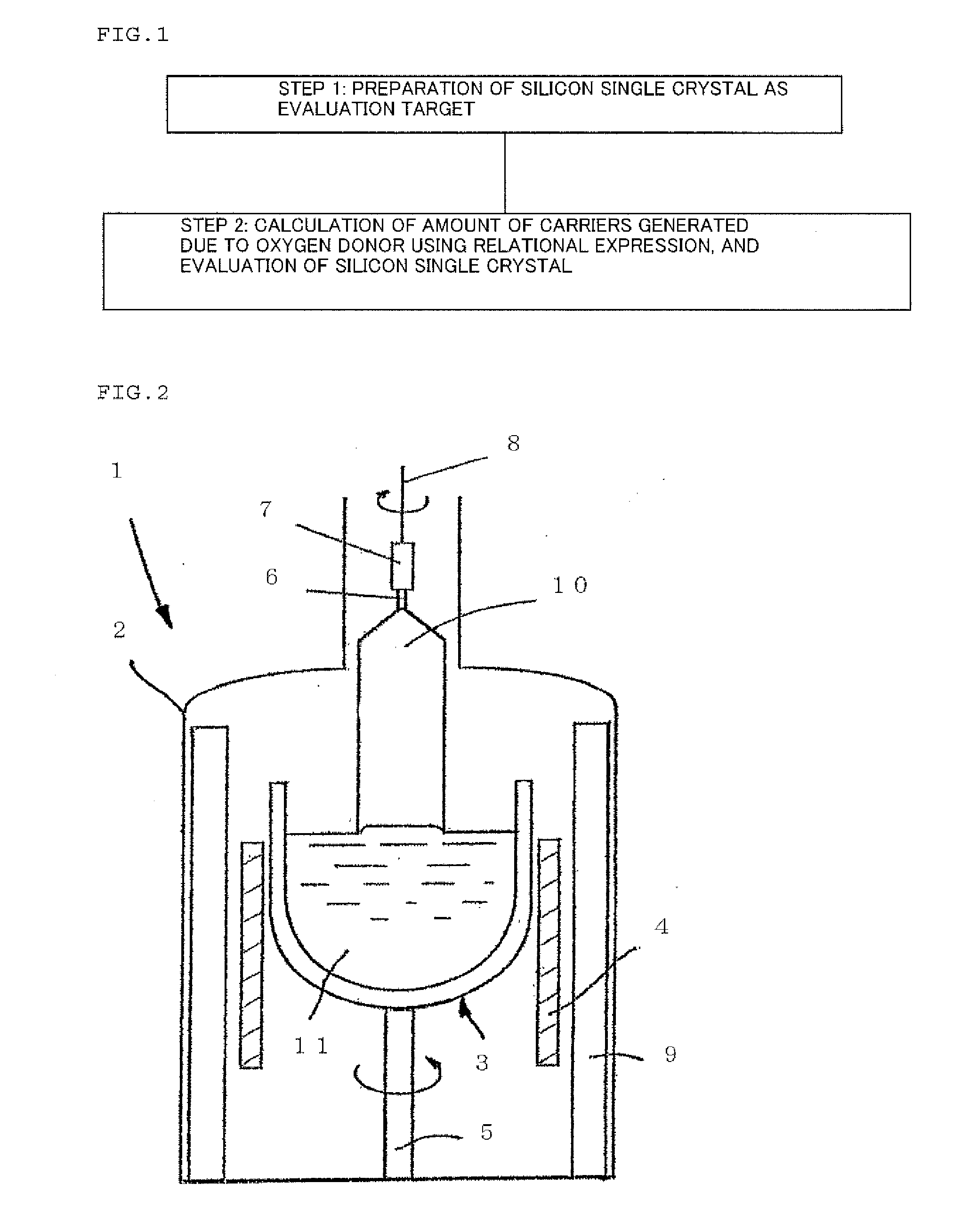Method for evaluating silicon single crystal and method for manufacturing silicon single crystal
a silicon single crystal and single crystal technology, applied in the direction of semiconductor/solid-state device testing/measurement, after-treatment details, instruments, etc., can solve the problems of reducing the concentration of silicon single crystal, increasing the cost, and shifting the resistivity of the substrate, so as to achieve high accuracy and enhance the effect of versatility
- Summary
- Abstract
- Description
- Claims
- Application Information
AI Technical Summary
Benefits of technology
Problems solved by technology
Method used
Image
Examples
experiment 1
[0082]First, the relational expression Δ[C]=α′[Oi]3×exp(−β′·D(T)·[Oi]·t) (where α′ and β′ are constants) derived from International Publication No. WO 2005 / 071144 and the like described above will be examined.
[0083]Like Step 1, P-type crystal having oxygen concentration distributed thereto is grown by using the CZ method and the MCZ method, and wafer-shaped samples were sliced out from this grown crystal.
[0084]Samples having the oxygen concentrations [Oi]=9.2×1017, 10.8×1017, 12.8×1017, 13.8×1017, and 15.9×1017 atoms / cm3 (ASTM' 79) were prepared.
[0085]Then, each sample was subjected to a donor killer heat treatment, then a PN determination and measurement of a resistivity. Subsequently, samples were divided into two groups and subjected to a heat treatment at 450° facilitating generation of oxygen donors on two levels, i.e., one hour (3600 seconds) and 15 hours (54000 seconds), respectively. Each sample was again subjected to the PN determination and the measurement of a resistivity...
experiment 2
[0090]Subsequently, whether Expression (1) could be used even in an extended lower oxygen concentration region was confirmed.
[0091]Like Experiment 1, samples each having oxygen concentration distributed thereto were prepared. However, oxygen levels are lower than those in Experiment 1, and they are 4.8×1017, 5.2×1017, 5.8×1017, 6.8×1017, and 8.0×1017 atoms / cm3 (ASTM' 79). Since the oxygen concentration must be lowered, the samples used here were all fabricated by using the MCZ method with a magnetic field applied.
[0092]These samples were subjected to the donor killer heat treatment, then the PN determination and the measurement of a resistivity. Subsequently, the heat treatment was carried out at 450° C. for one hour and for 15 hours, and the PN determination and the measurement of a resistivity were again performed in a completely the same manner as Experiment 1. Based on obtained results, an amount of carriers generated due to oxygen donors was obtained and plotted in FIG. 10 with...
experiment 3
[0095]However, using MCZ crystal in a low-oxygen concentration region that was not observed in the prior art can be expected, and hence an expression that can also represent a low-oxygen concentration side is preferable. Thus, an expression that substitutes for Expression (1) and enables obtaining an amount of carriers generated due to oxygen donors was keenly examined based on these pieces of data.
[0096]As a result, it was revealed that the following expression can be used with respect to the silicon single crystal in each of Experiments 1 and 2.
Δ[C]=5.78×10−74×[Oi]5×exp(−6.25×10−7×D(T)·[Oi]·t) Expression (2)
[0097]Specifically, on the low-oxygen concentration side in FIG. 10, experimental results (points) do not coincide with Δ[C]=4.53×10−39×[Oi]3×exp(−1.63×10−5×D(T)·[Oi]·t) (a line) of Expression (1) obtained in the experiment 1. When the oxygen concentration becomes lowered, the experimental values rapidly become smaller than Expression (1). Therefore, it is assumed that an inf...
PUM
| Property | Measurement | Unit |
|---|---|---|
| temperature | aaaaa | aaaaa |
| temperature | aaaaa | aaaaa |
| temperature | aaaaa | aaaaa |
Abstract
Description
Claims
Application Information
 Login to View More
Login to View More - R&D
- Intellectual Property
- Life Sciences
- Materials
- Tech Scout
- Unparalleled Data Quality
- Higher Quality Content
- 60% Fewer Hallucinations
Browse by: Latest US Patents, China's latest patents, Technical Efficacy Thesaurus, Application Domain, Technology Topic, Popular Technical Reports.
© 2025 PatSnap. All rights reserved.Legal|Privacy policy|Modern Slavery Act Transparency Statement|Sitemap|About US| Contact US: help@patsnap.com



